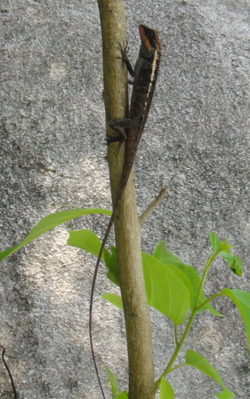Biology:Calotes emma
| Calotes emma | |
|---|---|

| |
| Scientific classification | |
| Domain: | Eukaryota |
| Kingdom: | Animalia |
| Phylum: | Chordata |
| Class: | Reptilia |
| Order: | Squamata |
| Suborder: | Iguania |
| Family: | Agamidae |
| Genus: | Calotes |
| Species: | C. emma
|
| Binomial name | |
| Calotes emma Gray, 1845[2]
| |
| Subspecies | |
| |
Calotes emma, commonly known as the forest garden lizard or Emma Gray's forest lizard, is a species of lizard in the family Agamidae. The species is native to China , South Asia, and Southeast Asia. There are two recognized subspecies.
Etymology
The specific name, emma, is in honor of English conchologist Maria Emma Gray, the wife of John Edward Gray, the describer of this species.[3]
Morphology
C. emma has the following morphology.
Physical Structure: There are three small groups of spines, completely separate from each other, on each side of the head, one behind the superciliary margin and two above each tympanum. The dorsal crest is well developed on the neck and on the anterior part of the trunk, gradually disappearing behind. There is a transverse fold in front of each shoulder, and the gular sac is but little developed. The tail is laterally compressed. There are about 51 series of scales round the middle of the trunk.[4]
Color pattern: The dorsum is brownish olive, with brown bands across the back, which are lighter in the middle and interrupted by a white band running along each side of the back. The eyelids have short, radiating brown streaks. There is a brown band from behind the eye to above the tympanum. The fold before the shoulder is black, with an irregular white margin. The legs and tail have indistinct dark crossbands.[4]
The maximum total length (including tail) is 40 cm (16 in).[citation needed] The usual total length is 28 cm (11 in), and the usual snout-to-vent length (SVL) a 7.5 cm (3.0 in).[4]
Geographic range
C. emma is found in Bangladesh (Satchari National Park, Bandarban Hill District), Cambodia, China (Guangdong, Yunnan), India (Assam), Laos, Malaysia (Peninsular), Myanmar, Thailand (including Phuket) & Vietnam (including Pulo Condore Islands) and Possibly in Bhutan.[citation needed]
"An inhabitant of Mergui, whence we have received it from Professor Oldham, ranging northwards perhaps to the Khasya Hills; extremely doubtful as an inhabitant of Afghanistan. Mr. Blyth mentions it amongst a collection made by Captain Bedmore at Schwe Gyen on the Sitang River in Pegu".[4]
Vernacular names
Vernacular names for C. emma in various languages include the following.
- Bengali: কেশর গিরিগিটি, ঝুঁটি গিরিগিটি, ঝুঁটি রক্তচোষা, যুথিয়াল গিরিগিটি (Juthial girigiti)
- Burmese: Poat-Tin-Nyo
- Chinese: 棕背树蜥
- English: crested forest lizard, Emma Gray's crested forest lizard, Emma Gray's forest lizard, spiny-headed forest lizard.
Behavior and habitat
C. emma is terrestrial, arboreal, and diurnal. It inhabits various forest habitats including dry deciduous, coastal, and moist evergreen.[1]
Diet
C. emma is insectivorous,[5] preying upon termites, grasshoppers, ants, cockroaches, beetles, diverse species of moths and low flying butterflies, and soil-living insects and their larvae.[6]
Reproduction
C. emma is oviparous.[7] The adult female lays 10-12 eggs in May–June. The incubation period is about 60–70 days.[citation needed]
Human uses
C. emma is used in the pet trade.[citation needed] It plays a role in the ecosystem by eating various types of insects and otherwise.[citation needed]
Threat to humans
C. emma is non-venomous and completely harmless to humans.[citation needed]
IUCN threat status
C. emma has been evaluated as "Least Concern" (LC) by the IUCN.[1]
Subspecies
Two subspecies of C. emma are recognized as being valid, including the nominotypical subspecies.
- Calotes emma alticristatus Schmidt, 1925 [7]
- Calotes emma emma Gray, 1845[7]
References
- ↑ 1.0 1.1 1.2 Wogan, G.; Lwin, K.; Cai, B.; Yang, J.; Das, A.; Hasan, M.K. (2021). "Calotes emma". IUCN Red List of Threatened Species 2021: e.T99928931A99928940. doi:10.2305/IUCN.UK.2021-3.RLTS.T99928931A99928940.en. https://www.iucnredlist.org/species/99928931/99928940. Retrieved 23 December 2022.
- ↑ Gray JE (1845). Catalogue of the Specimens of Lizards in the Collection of the British Museum. London: Trustees of the British Museum. (Edward Newman, printer). xxviii + 289 pp. (Calotes emma, new species, pp. 244–245).
- ↑ Beolens, Bo; Watkins, Michael; Grayson, Michael (2011). The Eponym Dictionary of Reptiles. Baltimore: Johns Hopkins University Press. xiii + 296 pp. ISBN:978-1-4214-0135-5. (Calotes emma, p. 83).
- ↑ 4.0 4.1 4.2 4.3 Günther ACLG (1864). The Reptiles of British India. London: The Ray Society. (Taylor and Francis, printers). xxvii + 452 pp. + Plates I–XXVI> (Calotes emma, p. 144).
- ↑ Tikader, B.K.; Sharma, R.C.. "Handbook of Indian Lizards". http://faunaofindia.nic.in/PDFVolumes/hpg/007/index.pdf.
- ↑ Agarwala, Basant K.; Majumder, Joydeb (February 2015). "Calotes emma Gray, 1845 (Squamata: Agamidae): Range extension and new addition to the reptilian fauna of Tripura, northeast India". Check List 11 (2): 1562. doi:10.15560/11.2.1562. https://www.researchgate.net/publication/271795923. Retrieved 26 January 2022.
- ↑ 7.0 7.1 7.2 Calotes emma at the Reptarium.cz Reptile Database. Accessed 9 December 2014.
External links
Further reading
- Boulenger GA (1885). Catalogue of the Lizards in the British Museum (Natural History). Second Edition. Volume I. ... Agamidæ. London: Trustees of the British Museum (Natural History). (Taylor and Francis, printers). xii + 436 pp. + Plates I–XXXII. (Calotes emma, p. 324 + Plate XXV, figure 1).
- Boulenger GA (1890). The Fauna of British India, Including Ceylon and Burma. Reptilia and Batrachia. London: Secretary of State for India in Council. (Taylor and Francis, printers). xviii + 541 pp. (Calotes emma, pp. 137–138).
- Schmidt KP (1925). "New Chinese Amphibians and Reptiles". American Museum Novitates (175): 1–3. (Calotes alticristatus, new species, p. 2).
- Smith MA (1935). The Fauna of British India, Including Ceylon and Burma. Reptilia and Amphibia. Vol. II.—Sauria. London: Secretary of State for India in Council. (Taylor and Francis, printers). xiii + 440 pp. + Plate I + 2 maps. (Calotes emma, pp. 195–197, Figure 55 [two views of head]).
Wikidata ☰ Q1037106 entry
 |


